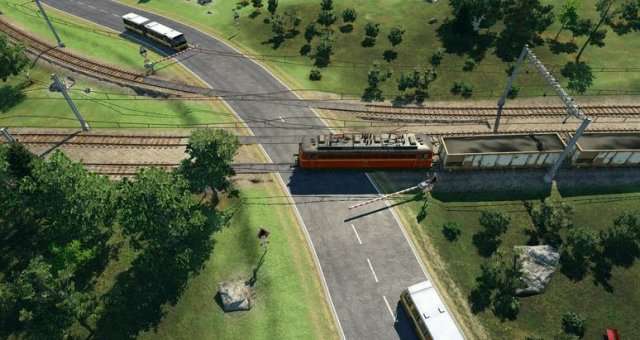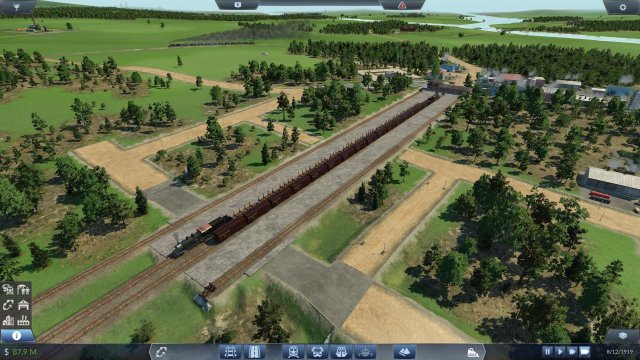
This is a easy to understand guide to help you to buy a functional transportation network and avoid different industries to stop production and break your chain production line.
Other Transport Fever Guides:
- Basic Guide for Beginners.
- Double and Triple Buffering Lines.
- How The Double Slip Switch Works.
- How to Get Easy Cash (Cheat).
Introduction
All credit goes to Optimus Princeps!
Tired of seeing your industries stop producing goods and breaking your transport network leading u to bankruptcy? Well, u are in te right place then. This guide is an easy and fast way to understand how to avoid that problem and successfully build your network. If u follow this simple rules your nightmare will end.. Guaranteed.
Basics
As I said in the introduction this is a fast and easy guide, so let’s go to the point.
If you wanna succed building your network u have to follow 2 simple gold rules.
- Stream line capacity is less or equal to city needs.
- Line transportation progression is always gretear or equal to the previous step on the network.
Now, you can say, it’s that easy? Well, it is. Following this 2 rules your network will work successfully and all u need to do is adjust it to make it profitable and sustainable.
Following this 2 rules it’s enough to assure that transportation network will NO BREAK. But let’s explain it and see how it works with more detail.
Development
As we see in the previous section of the guide we have to follow 2 simple rules that we are going to explain here.
Keep in mind that might be some special cases that you have to pay attention if you wanna create and expanded resource network but we will see that in the next steps of the guide, now we are going to foucs on make our basic newtrok work looking at the rules we discuss early on.
First Rule
Like we see before, the main stream production of our network has to be less or equal to the city needs. Lets see what that means.
As u can see here we need to open the line list (red square) so we can see now thanks to the latest patch the average annual capacity of our different lines.
Now we can see in the blue circles that our stone transportation capacity per year is 606 and our city needs 608. Thats awesome.
If we TRANSPORT more stone that our target city can consume the quarry will continue producing BUT we can’t transport all the produced goods so the quarry guys will be no happy at all because we don’t buy their surplus goods. That will lead quarry to stop producing stone and stop using our line totally breaking our network!
If we transport less than our city needs nothing bad will happen. The quarry will adapt his production to our transport capacity and continue producing and using line while we continue transportating all his stone. The ideal thing though is to transport equal goods to our city needs because we are maximizing our line rentability and our transports will do full cargo travels. In this case as I said having a 606 to 608 ratio is awesome and literally perfect.
Second Rule
The second gold rule tells us that we need to equalize or increase the lane capacity as we move forward on the transportation netowrk, as you know we don’t deliver stone directly to the city, we need to transfom it on construction materials. And this is when the second rule comes in to play Pure logic, let’s see how it works.
We transport the stone to the factory, remember we were transportating 606 wages per year (wpy). So what we need to do now with our shiny new construction materials? Exactly, transport this 606 wpy to the city and we need another 606 wpy line or greater.
Why we need this? Because if we don´’t transport all the materials produced from the stone stream the guys working at the factory will be upset and will stop producing and using our line just like the stone guys did before!
So what happens if we transtport less? Materials will start to stock and factory will stop producing and buying stone leading economy to colapse.
What happens if we transport more? Nothing “bad”. We sell all the materials produced so the factory will continue working with us. Our job now is trying to equalize our wpy from one line to the the other or our train will do some travels with no full cargo. Now we are losing some money. Line of course will be profitable if u can keep the lines razonable equal, but remember if not equal always greater:
A ≤ B ≤ C ≤ D… ≤ N A ≤ N
U can see in the image that I’m transporting 703 from factory to the city. 703 is greater than city needs but nothing happens because we are limited by the stone stream so factory will produce 606 as much. It’s not the most efficient line because im transporting around 100 empty wpy, but still winning money. Profitable, but maybe not efficient in hard mode. We should definetively adjust it more, but thats your job guys.
Special Cases
We see how to put to wok a simple network but keep in mind some special cases like:
- If u wanna supply 2 or more cities from a single factory u need to add the transportation values of your lanes to match the main source stream (supposing there is only one of them)
- Remember that some goods need 2 wages of raw materials to be produced. So in this case the main stream line has to be twice the city needs, even if it is greater than the next network step.
- Also, iron needs 2 different raw materials to produce, so u will need 1 line to each resource matching city needs.
Also, keep in mind than factories will not use your transportation lines if your network has insane frecuency values. They will not wait for u forever.









Be the first to comment